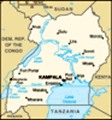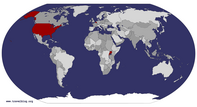Advertisement
Published: January 1st 2018
Gorillas. Today I am going to go trekking for gorillas.
Everyone who I have met that has done a gorilla trek has said it is the most amazing thing to do, much better than any safari. This had to be great, as going on safaris is the #1 thing for me to do. I am addicted to them. I had to wake up at 4 am today, as the drive to the ranger station would take at least two hours. We had to leave no later than 5 am, and check in before a certain time, or you would not be allowed to trek. Given that it had rained all night, I wanted to ensure we left early enough to account for any mishaps along the way, or at least have time to make our way thru the mud, as these roads were not tarred, and it was all mountain driving. There was no rain when we left, or while we made the drive, and when the sun rose, the scenery was nothing short of spectacular. It also didn't look like there would be any rain that day, as the sky was clear, and a bit sunny.

 Uganda countryside
Uganda countryside
This part of the country consists of mountains and valleys, so beautiful.It is said that the groups who get to the ranger station first get to pick the family they want to visit; each family varies in makeup and size. The ranger station also tries to accommodate the fitness level of the trekkers. Those who are not as fit get to visit the families closest to the ranger station, and the strongest ones will get assigned to the families furthest away. The closest family is about 1.5 hours from the ranger station, and the furthest can be five to six hours away. They also encourage you to hire a porter to help you make the trek, as the forest is thick, and walking sticks don't always keep you in an upright position. The groups are limited to no more than eight tourists, any porters hired, and two to three guides, who carry machetes to make paths to walk thru, and rifles to protect you from wayward animals and people. If you have even the slightest illness -- a cold, diarrhea, or anything else, you are not to make the trek, as you can pass it on to the gorillas. Anything you take with you into the forest has to
be brought out by you, no exceptions. Your guide will know where to take you, as there are trekkers who follow the families 24/7, and they are in constant contact via walkie-talkies with the guide as to their location. Before you can start the trek, they take you thru safety instructions -- what to do if they come up to you, or charge at your, how to respond to the babies -- who often want to play with you, etc., and remind you that there is the possibility that you may not see the gorillas, as they are unpredictable. But the odds are in your favor: 90% likelihood people will see them. How many you see, and their visibility, is dependent on them. When the gorillas are found, the ranger station reminds you many times over, you have only one hour to view them. At the end of the day, all groups will reconvene at the ranger station, where a ceremony will be held, certificates will be handed out, and you are congratulated for seeing the gorillas.
I was assigned to a group with six other trekkers, and we were to visit a family that consisted of
12 gorillas, including one silverback -- the one gorilla everyone wants to see, and a few babies, which were located only 1.5 hours away. We were assigned to the closest family. In theory, the entire trek would take four hours: 1.5 hours to get to them, one hour for observation, then another 1.5 hours to return. I thought this was a good omen, as we would likely avoid any potential rain for the two most important legs of this journey: getting to, and seeing, the gorillas. Well, things don't always turn out as predicted or planned. (Nature + animals =
very unpredictable)
As we trekked into the forest, heading toward the gorillas, the gorillas decided to do likewise, but in the opposite direction. As a result, we had to climb up one mountain, then down it to reach the other mountain to where they were headed. The forest was thick, and steep, and the porters really made a difference. The more we trekked, the further those damn gorillas did, too. Whenever the lead ranger spoke with the trekkers who were with the gorillas, we could tell from the tone of the conversation things weren't looking good. This
was further compounded by his conversations in the local language with the porters. After a few hours of trekking, the guide told us that we had to remember that, while 90%!o(MISSING)f the time you get to see gorillas, there is that 10%!c(MISSING)hance you won't see them. We were all convinced we wouldn't be seeing any gorillas.
Then the rain came. Not only did it come, it came down hard and heavy. With the exception of one person who was totally not dressed properly -- but she did bring a bottle of rum to keep her happy, the rest of us were in our expensive hiking boots, water proof jackets and pants, ready for the journey. And we all came to learn on this trek that
nothing is water proof. (I once had a salesclerk at a sporting goods store tell me there is no such thing as water proof, only water resistant, and not to believe otherwise. That conversation played out in my head while we hiked thru the heavy rain.) We were all soaked to the bone -- I doubt there was even one part of our bodies that were dry, it was like

 Bwindi
Bwindi
The gorillas weren't cooperative in posing for picturesbeing in a shower with our clothes on. Everyone was miserable, with a few wanting to quit. The lead ranger wouldn't hear of it. We paid to see gorillas, and he was going to find them for us, so on we went.
As much as we detested the rain, so did the gorillas. It was during the rainfall that they became stationary, as they took shelter. And so, after 5.5 hours of exhaustive hiking up and down two mountains and making our way through the thick brush, we finally reached their location. At first we saw only a mother and baby sitting under a large palm-like leaf, trying to stay dry. Most people were like, okay, I saw gorillas in the wild, now lets go home. The ranger, thankfully, didn't go with the majority of the group's sentiments. He had us stand under a tree with barely any leaves to be rained on, while we waited for the rain to stop. None of us believed it would, having experienced the continual rains over the past few days, and we were in a
rain forest. It came down so heavy, and it didn't seem like it would ever
stop. Then, after more than an hour, the rain did stop. The gorillas decided to come out of their shelter, and make their way to a small clearing about 50 yards from where we were standing. The silverback was there to greet us, and pounded on the ground to let us know we weren't welcome. It was huge. We saw about seven in total; we could hear the others, but never saw them. The lead ranger was kind enough to give us more than one hour to spend with them due to all that we went thru. They went about their business, with us having to keep a distance of about 20 feet from them, though they can approach you. None did in our group. And as other reviewers put it, once you see the gorillas just feet away, you forget whatever you endured to get to their location. I felt that way, but the majority of my group didn't. They swore they'd stick to zoos.
After the allotted time was up, it was time to return to the ranger station. It started getting dark, and none of us wanted to be in there in that condition,
so we hiked faster than we ever have. Due to the heavy rain, there were rivers of water that we had to cross. Initially, our feet were wet from our socks being wet, but now our boots were full of water, as these rivers were deeper than the height of our boots. By the time we made it to the ranger station, no one was there, but the drivers from our tour companies, waiting to take us to our lodges for the night. They were given our certificates; no one else wanted to wait for us in the dark or with the heavy rains. Luckily for me, my lodge for the night was only ten minutes from the ranger station. The group who I had trekked with were all staying in lodges over two hours away, more likely three with the muddy roads and rain. I could not wait to peel my wet clothes off of me. It took my boots one week to dry, and all I had with me was a pair of sandals as backup. Not very good planning on my part for the rainy season.
The porters are definitely worth hiring; I think
it is $24 for the day. They will practically carry you across the forest, move the branches out of the way for you to cross, in addition to carrying your bags while they do this. We all fell a few times, not the fault of the porters, but due to the steepness of the mountains, and the roots that would catch your boot. They did everything possible to help you, and were more useful than the walking sticks. You also bring employment to the region. The porters -- male and female -- are given an opportunity one day each month to possibly be chosen by a tourist. It's too bad there are more porters than tourists, and this was low season, so more than the usual would go unemployed.
I did meet a few people who had done the trek the same day as me. A few had made it back before the rain, while others got rained on while they were heading back to the ranger station. This made a big difference for their experience, and the families they visited. As much as we hated the rain, it's probably what assured us of seeing our family,
or they'd likely have continued moving deeper into the forest. We would have become part of the 10%, which would have been very disappointing. That is why the smart traveler books two treks, just in case the first one turns out not to be a good experience. Who would have thought the family closest to the ranger station would be the ones on the move and be the furthest family? I would have been worried if I had been assigned to the family 5 -- 6 hours away. That's just your starting point! No two groups are assigned to the same family.
I would encourage everyone to do a gorilla trek, but I would just as strongly encourage people to do it during the dry season.
Advertisement
Tot: 0.09s; Tpl: 0.012s; cc: 12; qc: 50; dbt: 0.0455s; 1; m:domysql w:travelblog (10.17.0.13); sld: 1;
; mem: 1.2mb



















